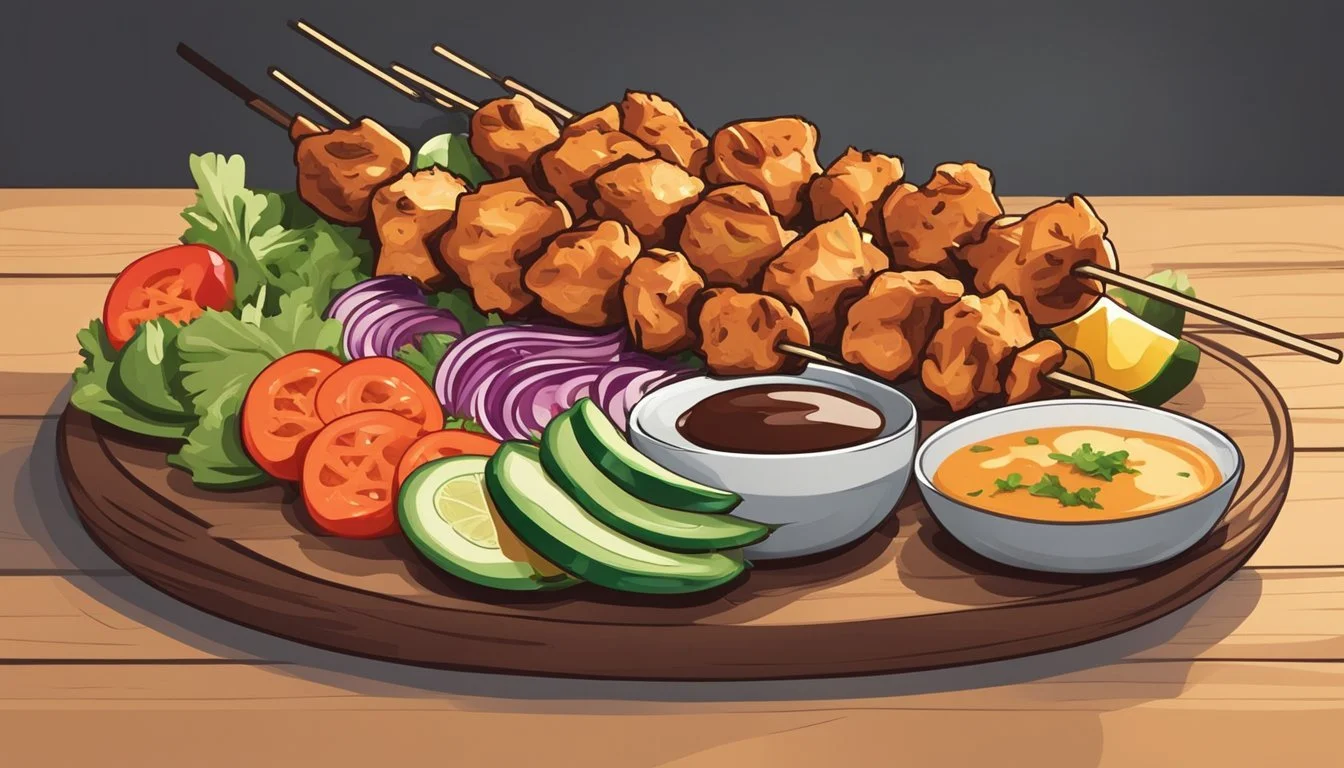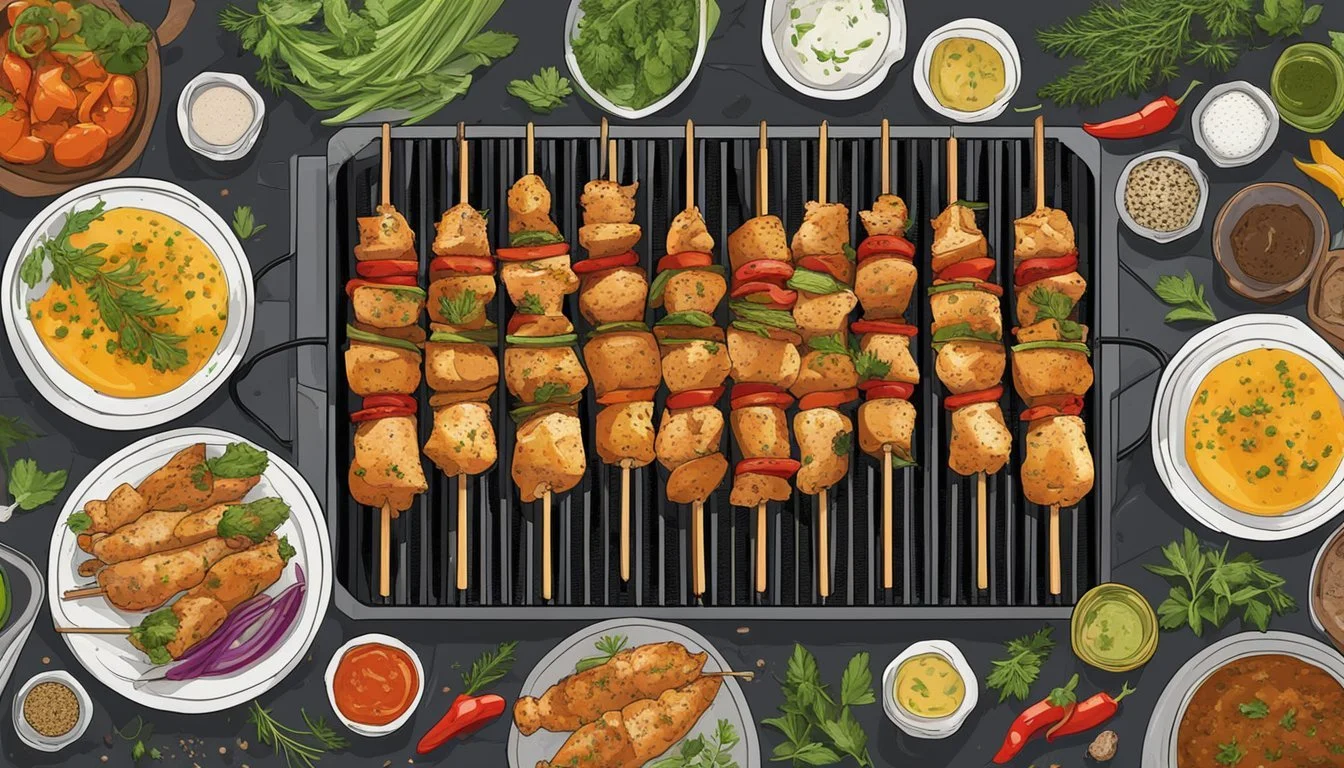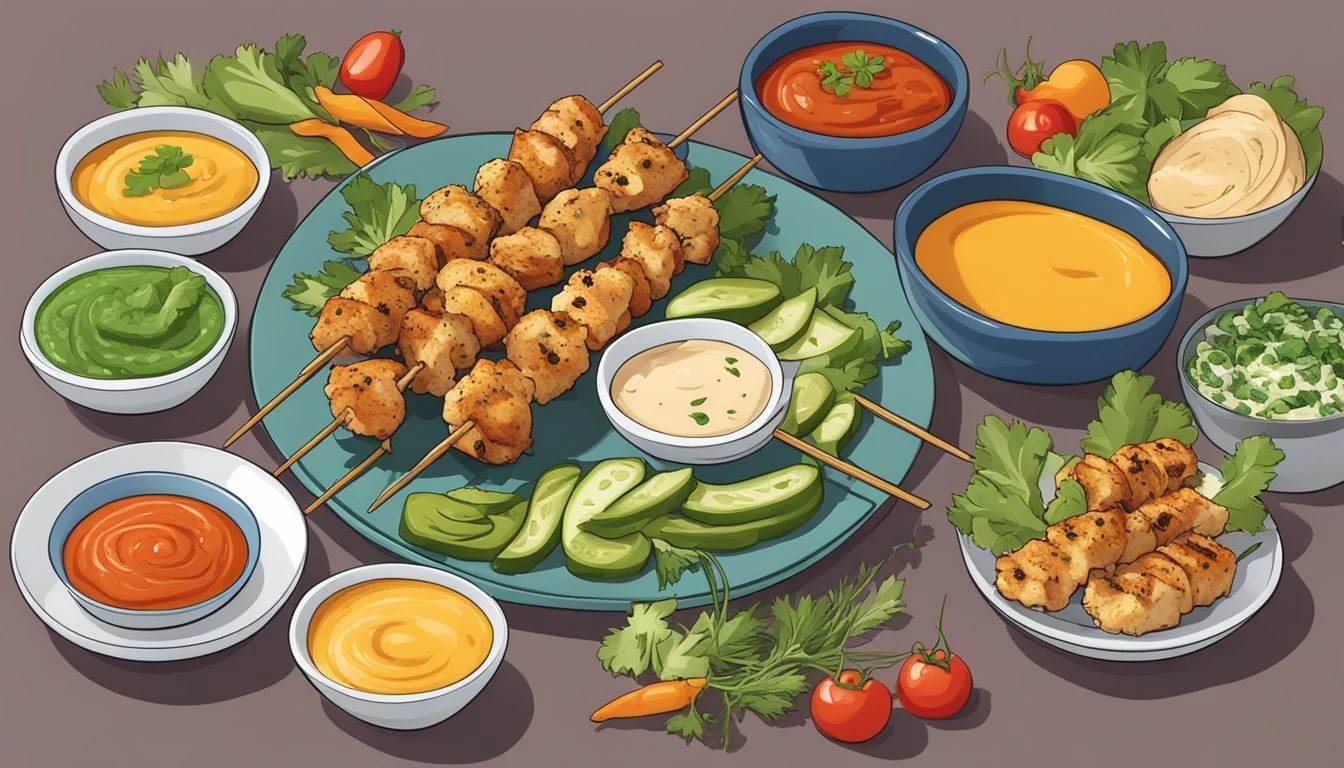How Long Do Chicken Kebabs Last?
Storage Tips and Safety Guidelines
Chicken kebabs are a versatile and delightful dish, perfect for meals any time of the year. Their savory flavors make them an easy favorite at any gathering. When cooked and stored properly, chicken kebabs can last up to 3-4 days in the refrigerator.
Ensuring the kebabs are promptly stored in airtight containers helps maintain their freshness. For those looking to make meals ahead of time, freezing chicken kebabs can extend their shelf life to about 2-3 months. This makes them a convenient option for busy weeknights or spontaneous get-togethers.
Knowing how long chicken kebabs last not only helps in meal prepping but also ensures food safety. Properly handling and storing them preserves their taste and prevents any potential foodborne illnesses. Enjoying flavorful chicken kebabs starts with knowing how to keep them fresh and safe.
Essential Ingredients for Chicken Kebabs
Creating delicious chicken kebabs involves selecting the right chicken cut and balancing flavors with a proper marinade. Adding complementary vegetables further enhances the dish.
Choosing the Right Chicken
Selecting the appropriate chicken cut is crucial. Chicken thighs are ideal due to their juicy texture, which remains tender even after grilling. Chicken breasts can also be used but may need extra care to prevent dryness.
Opt for boneless, skinless pieces for easier preparation and cooking. Ensure uniform cutting for even cooking and consistent flavor throughout the kebabs.
Marinade Components for Flavor and Tenderness
A marinade is essential for infusing flavor and ensuring tenderness. Key ingredients include:
Lemon juice: Adds acidity to tenderize the chicken.
Garlic: Provides a rich, aromatic depth.
Salt and pepper: Essential for seasoning.
Olive oil: Facilitates even cooking and adds moisture.
Herbs and spices: Consider using rosemary, thyme, paprika, or cumin to enhance the flavor profile.
Mix these ingredients and let the chicken marinate for at least 30 minutes, preferably overnight.
Vegetables and Additional Ingredients
Complementary vegetables add texture and nutritional value. Popular choices include:
Bell peppers: Red, yellow, and green varieties offer color and sweetness.
Onions: Red onions provide a mild sweetness, while white onions give a sharper flavor.
Zucchini: Adds a slight crunch and absorbs marinade flavors well.
Other possibilities include cherry tomatoes, mushrooms, or even chunks of pineapple for a sweet contrast.
When threading the skewers, alternate between chicken and vegetables to ensure a balanced cook and flavor distribution.
Preparing Your Chicken Kebabs
Proper preparation of chicken kebabs involves marinating the chicken, selecting the right skewers, and ensuring correct cooking times and temperatures.
Marinating Your Chicken
Marinating is important for flavor and tenderness. Mix ingredients such as olive oil, lemon juice, garlic, salt, and pepper. Add herbs like thyme or rosemary for extra flavor. The chicken should marinate for at least 30 minutes, but for best results, let it sit for 2-4 hours in the refrigerator. Use a resealable bag or a covered dish to avoid contamination.
Skewering Techniques
Skewers come in two main types: wooden and metal. Wooden skewers should be soaked in water for at least 30 minutes to prevent burning. Metal skewers don't need soaking and can be reused. When skewering, leave a small space between each piece to ensure even cooking. Alternate chicken with vegetables like bell peppers or onions for variety.
Cooking Time and Temperature
Chicken kebabs should be cooked at 400°F (200°C) for about 20-25 minutes if using an oven. Turn them halfway through for even cooking. On a grill, cook for 10-15 minutes per side. The internal temperature should reach 165°F (74°C). Use a meat thermometer to ensure accuracy. Place the skewers on a baking sheet if cooking in the oven to catch any drips.
Cooking Methods for Optimal Taste and Texture
Cooking chicken kebabs to achieve the best taste and texture varies by method. Key elements include maintaining moisture, ensuring thorough cooking, and achieving desired textures.
Grilling on an Outdoor Grill
Grilling is a popular cooking method for chicken kebabs. Preheat the grill to medium-high. Thread chicken pieces onto skewers, leaving small gaps for heat circulation.
Basting: Frequently baste with marinade or oil to keep the meat moist. Turn skewers occasionally to prevent burning and ensure even cooking.
Texture: Grilling imparts a smoky flavor and creates a crisp exterior. Ensure the internal temperature reaches 165°F (74°C) for safety. Use a grill pan if you prefer more control over smaller pieces.
Baking in the Oven
Baking is reliable and convenient for cooking chicken kebabs indoors. Preheat the oven to 400°F (200°C). Line a baking sheet with aluminum foil for easy cleanup.
Preparation: Place skewered chicken on the sheet with space between pieces. Optionally, broil the kebabs during the last few minutes to enhance browning.
Texture: Oven baking maintains even cooking and tenderness. Use a meat thermometer to confirm an internal temperature of 165°F (74°C). Rotate skewers halfway to ensure consistent cooking.
Alternative Cooking Techniques
Broiling: Set the oven to broil for quick, high-heat cooking. Place kebabs on a broiler pan. Watch closely to prevent burning, turning frequently.
Stovetop: Use a grill pan over medium-high heat. Cook in batches if needed, ensuring each piece has contact with the pan’s surface.
Slow Cooking: Ideal for a hands-off approach. Place skewers in the slow cooker with a bit of broth or marinade. Cook on low for 4-6 hours until tender.
Each method offers unique advantages. Choose based on available equipment and desired results.
Serving Suggestions for Chicken Kebabs
Chicken kebabs can be paired with various side dishes to enhance their flavors and make a complete meal. Options include rice, fresh salads, pita bread, and sauces like tzatziki.
Accompaniments and Side Dishes
Rice: Serving chicken kebabs with rice is a popular option. Choices include aromatic basmati rice, pilaf, or a simple side of steamed rice. Adding herbs like parsley or cilantro can elevate the flavor.
Salad: A fresh salad complements the grilled flavors of chicken kebabs. Greek salad with tomatoes, cucumber, olives, and feta cheese is an excellent choice. A simple garden salad with a light vinaigrette also works well.
Pita Bread: Offering pita bread as a side allows diners to create their own wraps. They can fill the pita with chicken kebabs, fresh vegetables, and sauces for a convenient and tasty meal.
Tzatziki Sauce: Tzatziki, made from yogurt, cucumber, garlic, and herbs, is a refreshing dip. It perfectly balances the savory flavors of grilled chicken kebabs. This sauce can be served on the side or drizzled over the kebabs.
Storing and Reheating Chicken Kebabs
Proper storage and careful reheating of chicken kebabs extend their freshness and ensure safety.
Proper Storage Practices
To maximize the shelf-life of chicken kebabs, store them in the fridge within two hours of cooking. Use an airtight container to prevent bacterial growth and maintain moisture. In the fridge, chicken kebabs typically last 3-4 days.
For longer storage, freeze cooked chicken kabobs. Place them in a single layer on a baking sheet to freeze first, then transfer to a freezer-safe bag. This method avoids sticking and keeps them good for up to 2-3 months. Label the bags with the date for easy tracking.
Reheating for Best Quality
Reheating chicken kebabs requires care to avoid dryness and ensure even warming. Oven reheating is effective: preheat to 350°F (175°C), place kebabs on a foil-lined tray, and cover loosely with foil. Bake for 10-15 minutes.
The skillet method involves adding a tablespoon of oil to a pan on medium heat. Heat kebabs for about 30 seconds on each side, stirring to ensure even warming. If the kebabs seem dry, add a lid to the pan to create steam.
Food Safety and Shelf Life Considerations
When storing chicken kebabs, it is essential to prioritize food safety measures and understand their shelf life to prevent foodborne illnesses. Proper storage conditions—such as refrigeration and freezing—are critical in maintaining the quality and safety of chicken kebabs.
Preventing Foodborne Illness
To avoid foodborne illnesses, chicken kebabs must be handled and stored correctly. Refrigeration is vital. Store chicken kebabs at or below 40°F (4°C) immediately after preparation to inhibit bacterial growth. Avoid leaving chicken kebabs at room temperature for more than 2 hours, as this can increase the risk of bacteria such as Salmonella and Campylobacter.
When reheating, ensure that the internal temperature of the chicken kebabs reaches 165°F (74°C) to kill any harmful bacteria. Proper hygiene and cooking practices are essential, including washing hands, using clean utensils, and not cross-contaminating cooked and raw ingredients.
Determining the Shelf Life of Chicken Kebabs
The shelf life of chicken kebabs varies based on storage methods. Refrigerated chicken kebabs last about 3-4 days when cooked, while raw assembled kebabs should be cooked within 1-2 days. Frozen cooked chicken kebabs can maintain quality for up to 3 months at 0°F (-18°C) before starting to dry out and lose flavor.
Key points for storage:
Refrigeration: Cooked kebabs last 3-4 days.
Room temperature: Safe for up to 2 hours.
Freezing: Retain quality for up to 3 months.
Maintaining these storage guidelines ensures chicken kebabs remain safe to eat and retain their best quality.
Flavor Enhancements and Variations
Chicken kebabs can be made more flavorful with various seasonings, marinades, and ingredient combinations. These enhancements allow for customization to suit different tastes and seasonal availability.
Exploring Different Seasonings and Marinades
Marinating chicken before cooking is a key way to infuse it with flavor. Lemon juice adds a fresh, tangy note and helps tenderize the meat. Paprika gives smokiness and depth, while cumin and coriander provide a warm, earthy flavor profile. Oregano, often used in Mediterranean cooking, offers a herbaceous touch. Soy sauce can be included for umami richness. Mixing these ingredients in various combinations can create unique and delicious marinades.
Suggested Marinade:
1/4 cup lemon juice
1 tablespoon paprika
1 teaspoon cumin
1 teaspoon coriander
2 tablespoons soy sauce
1 tablespoon chopped oregano
Marinate the chicken in this mixture for at least 2 hours, or preferably overnight, before grilling.
Creating Variations for All Seasons
Chicken kebabs can be adapted to fit any season. In summer, vegetables like bell peppers, zucchini, and cherry tomatoes add color and freshness. Chunks of pineapple can be added for a sweet contrast.
During cooler months, root vegetables and hearty greens can be used. Consider adding cubed butternut squash or Brussels sprouts to autumn and winter kebabs. Spices like cinnamon or nutmeg can be included in the marinade for an added warming effect.
By adjusting the ingredients and flavors to match the season, chicken kebabs can remain a favorite dish year-round. Experimenting with different combinations keeps the dish exciting and versatile, suitable for any time of the year.
Make-Ahead Kebabs for Easy Meal Planning
Preparing chicken kebabs in advance not only saves time but also ensures you have a healthy and convenient main dish ready to go. Properly prepping the kebabs can streamline your meal preparation for the week.
Prepping Kebabs for Future Use
Start by marinating the chicken to infuse it with flavor. Use ingredients like soy sauce, garlic, and olive oil.
Cut the chicken into uniform pieces to ensure even cooking.
After threading the chicken onto skewers, store them in an airtight container or wrap them tightly with cling film.
For freezing, place the skewers on a baking sheet and freeze until solid before transferring to a freezer-safe bag. Thaw the kebabs in the refrigerator overnight before cooking. This method ensures they retain their flavor and texture, making them easy to cook when needed.
Creative Ways to Enjoy Leftover Chicken Kebabs
Leftover chicken kebabs can be transformed into various delectable dishes, keeping mealtime exciting and reducing food waste. By using different ingredients and a bit of creativity, these kebabs can become the centerpiece of a new meal.
Reinventing Kebabs in Different Meals
Salads: Shred the leftover chicken kebabs and add them to a fresh salad. Toss with mixed greens, cherry tomatoes, cucumber, and a light vinaigrette. This not only enhances the salad's flavor but also boosts its protein content.
Wraps and Sandwiches: Use the chicken kebabs as a filling for wraps or sandwiches. Combine with lettuce, tomatoes, avocados, and your favorite sauce for a juicy and flavorful lunch option.
Pasta Dishes: Dice the kebabs and add them to pasta dishes. They pair well with creamy Alfredo sauce or a tangy marinara. The chicken's aroma and taste will infuse the dish, making it more appealing and nutritious.
Stir-fries: Incorporate the kebabs into a quick stir-fry. Combine with bell peppers, onions, broccoli, and a soy-based sauce. The kebabs retain their nutrition information while adding a rich taste to the stir-fry.
Soups and Stews: Add the kebabs to soups or stews. Whether it’s a chicken noodle soup or a hearty vegetable stew, the leftover kebabs will enhance the broth with their seasoned flavor.
Lists and tables organize ideas and provide clear instructions for transforming leftover chicken kebabs into versatile new meals.










